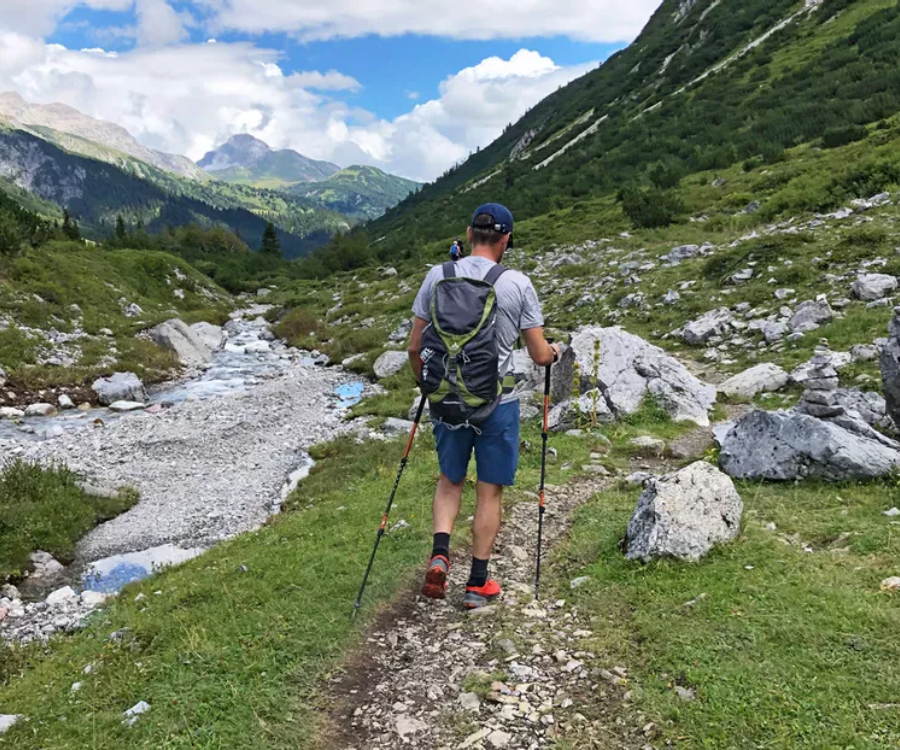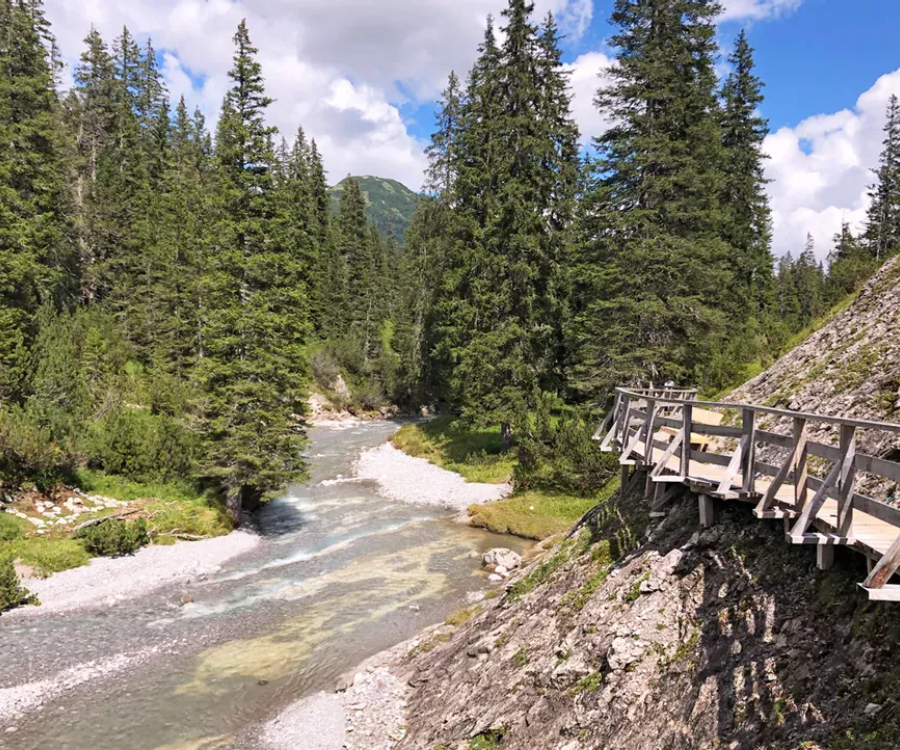
The Rheinsteig is a long-distance hiking trail that runs along the right bank of the River Rhine in Germany. It stretches for about 320 kilometers (approximately 199 miles) from Bonn to Wiesbaden. The trail passes through three German states: North Rhine-Westphalia, Rhineland-Palatinate, and Hesse.
In Hesse, the Rheinsteig passes through scenic landscapes, vineyards, and historic towns. Notable points along the trail in Hesse include the Rheingau region, which is famous for its wine production, and the town of Rüdesheim am Rhein, known for its picturesque old town and wine taverns. The trail offers stunning views of the Rhine Valley and its surroundings, making it a popular destination for hikers and nature enthusiasts.


The Rheinsteig was inaugurated on September 8, 2005, as a collaborative effort between the German states of North Rhine-Westphalia, Rhineland-Palatinate, and Hesse, along with various tourism associations. The trail was designed to offer hikers a well-marked, scenic route along the right bank of the Rhine River, featuring diverse landscapes, cultural sites, and historical landmarks.
The trail has since gained popularity among hiking enthusiasts for its well-maintained paths, beautiful views of the Rhine Valley, and the opportunity to explore vineyards, forests, and charming towns along the way. The Rheinsteig is divided into 23 stages, allowing hikers to plan their trips according to their preferences and abilities. The route includes notable attractions such as the Lorelei rock, various castles, and the cultural and wine-rich Rheingau region.

The Rheinsteig was developed as a collaborative effort involving multiple organizations and stakeholders. Key players included:
1. **Tourism Associations:** Regional tourism boards and associations from the states of North Rhine-Westphalia, Rhineland-Palatinate, and Hesse played a significant role in planning and promoting the trail. These organizations saw the potential for attracting tourists and boosting local economies through the creation of a scenic and culturally rich hiking route.
2. **Government Agencies:** Various government bodies at the state and local levels were involved in the development process, providing funding, resources, and support for the project. Their involvement ensured that the trail met high standards of quality and safety.
3. **Nature and Hiking Clubs:** Local hiking clubs, nature conservation groups, and volunteers contributed to the design and maintenance of the trail. Their expertise in local geography and natural preservation was crucial in establishing a route that was both enjoyable for hikers and respectful of the environment.
4. **Private Sector:** Businesses, particularly those in the hospitality and tourism industries, supported the project by offering services and amenities for hikers. This included accommodations, restaurants, and guided tours.
The collaboration between these various entities ensured the successful creation and launch of the Rheinsteig in 2005, making it a well-regarded destination for hikers from around the world.


The name "Rheinsteig" is derived from two German words: "Rhein," which refers to the Rhine River, and "Steig," which translates to "steep path" or "trail." Thus, "Rheinsteig" can be roughly translated to "Rhine Trail" or "Rhine Path."
The name aptly reflects the trail's characteristics:
1. **Rhein (Rhine):** The trail runs along the right bank of the River Rhine, one of Europe's major rivers. The Rhine Valley is renowned for its picturesque landscapes, vineyards, castles, and historic towns, all of which are accessible along the Rheinsteig.
2. **Steig (Trail/Path):** The trail is designed for hiking, with routes that often involve steep climbs and descents, providing hikers with both a physical challenge and rewarding scenic views.
The name Rheinsteig effectively captures the essence of the trail, highlighting its connection to the Rhine River and its nature as a hiking path through varied and often rugged terrain.




The Rheinsteig is considered a top destination for hiking enthusiasts for several compelling reasons:
1. **Scenic Beauty:**
- The trail offers breathtaking views of the Rhine Valley, with its rolling hills, lush forests, and picturesque vineyards.
- Hikers can enjoy stunning panoramas of the river, especially from the elevated sections of the trail.
2. **Historic and Cultural Sites:**
- The Rheinsteig passes by numerous castles, fortresses, and historic towns, allowing hikers to explore rich cultural and historical heritage.
- Notable landmarks include the Lorelei rock, Marksburg Castle, and the towns of Rüdesheim and Koblenz.
3. **Varied Landscapes:**
- The trail traverses diverse landscapes, including dense woodlands, open meadows, rocky cliffs, and terraced vineyards.
- This variety provides a dynamic and ever-changing hiking experience.
4. **Well-Marked and Maintained:**
- The Rheinsteig is well-marked with clear signage, making it easy for hikers to follow the trail without getting lost.
- The trail is well-maintained, ensuring safety and accessibility for hikers of varying skill levels.
5. **Flexible Stages:**
- The trail is divided into 23 stages, allowing hikers to choose segments that match their fitness levels and time constraints.
- This flexibility makes it suitable for both day hikers and those seeking longer, multi-day treks.
6. **Access to Amenities:**
- Along the trail, there are numerous accommodations, ranging from hotels and guesthouses to campsites, catering to different preferences and budgets.
- Many towns along the route offer amenities such as restaurants, shops, and transportation options, making it convenient for hikers to plan their journeys.
7. **Seasonal Appeal:**
- The Rheinsteig can be enjoyed in different seasons, each offering unique experiences. Spring brings blooming flowers, summer offers warm and sunny weather, autumn showcases vibrant foliage, and winter provides a peaceful, less crowded environment.
8. **Wine Culture:**
- The trail runs through the renowned wine-growing region of the Rheingau, giving hikers the opportunity to visit vineyards, taste local wines, and learn about viticulture.
These factors combine to make the Rheinsteig a highly appealing and rewarding destination for hiking enthusiasts.






The Rheinsteig is indeed a fantastic hiking destination year-round, with each season offering unique experiences:
1. **Spring:**
- **Blooming Nature:** The trail comes alive with vibrant wildflowers and blossoming trees.
- **Mild Weather:** Pleasant temperatures make for comfortable hiking conditions.
- **Wildlife:** Increased wildlife activity can be observed.
2. **Summer:**
- **Long Days:** Extended daylight hours allow for longer hikes and more time to explore.
- **Warm Temperatures:** Ideal for enjoying the scenic views and taking breaks in the sun.
- **Festivals:** Many local festivals and events take place, providing cultural experiences.
3. **Autumn:**
- **Colorful Foliage:** The trail is adorned with stunning fall colors as the leaves change.
- **Harvest Season:** Vineyards are bustling with grape harvests, and wine tasting is at its peak.
- **Cooler Temperatures:** Comfortable for hiking without the heat of summer.
4. **Winter:**
- **Peaceful Atmosphere:** Fewer hikers mean a quieter, more serene experience.
- **Crisp Air:** Fresh, crisp air makes for invigorating hikes.
- **Scenic Views:** Snow-dusted landscapes and clear views of the Rhine add a magical touch.
Each season enhances the Rheinsteig's appeal in different ways, ensuring that hikers can enjoy its beauty and challenges throughout the year.